Essay on Lifelong Learning: Importance, Methods, and Challenges
VerifiedAdded on 2021/04/17
|10
|2948
|52
Essay
AI Summary
This essay provides a comprehensive overview of lifelong learning, defining it as the continuous pursuit of knowledge for personal or professional growth. It emphasizes the significance of lifelong learning in enhancing active citizenship, social inclusion, and employability, as well as its positive effects on mental and physical well-being. The essay explores various methods for engaging in lifelong learning, such as staying informed, reading widely, experimenting with different learning approaches, and attending real-world classes. It also discusses how schools can prepare young learners to embrace lifelong learning by fostering attributes like critical thinking, self-direction, and effective communication. Finally, the essay addresses the challenges faced while engaging in lifelong learning, including time constraints, overcoming habits, and the need for support, concluding that lifelong learning is essential for personal and professional development in a dynamic world. This essay is available on Desklib, a platform offering study tools for students.
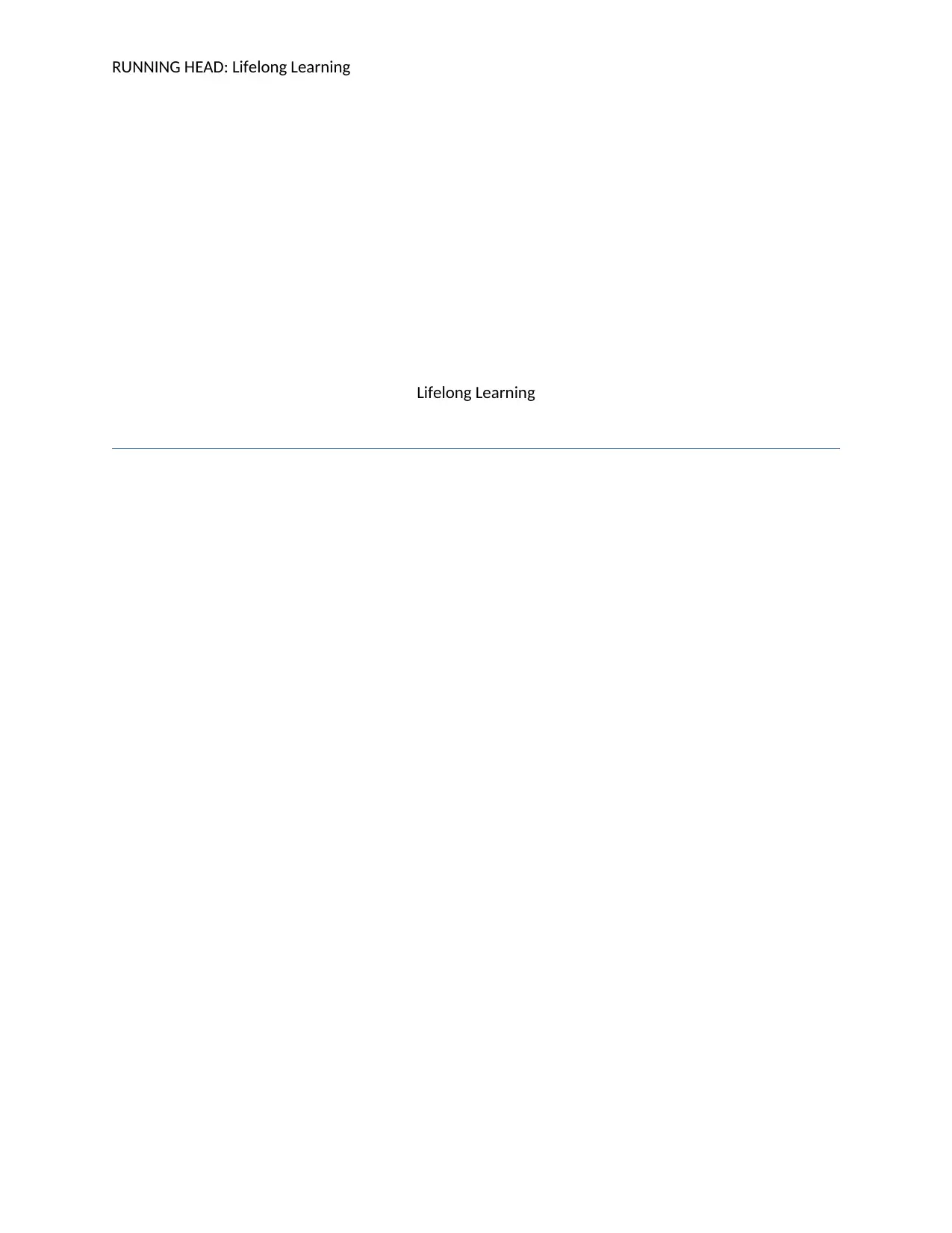
RUNNING HEAD: Lifelong Learning
Lifelong Learning
Lifelong Learning
Paraphrase This Document
Need a fresh take? Get an instant paraphrase of this document with our AI Paraphraser
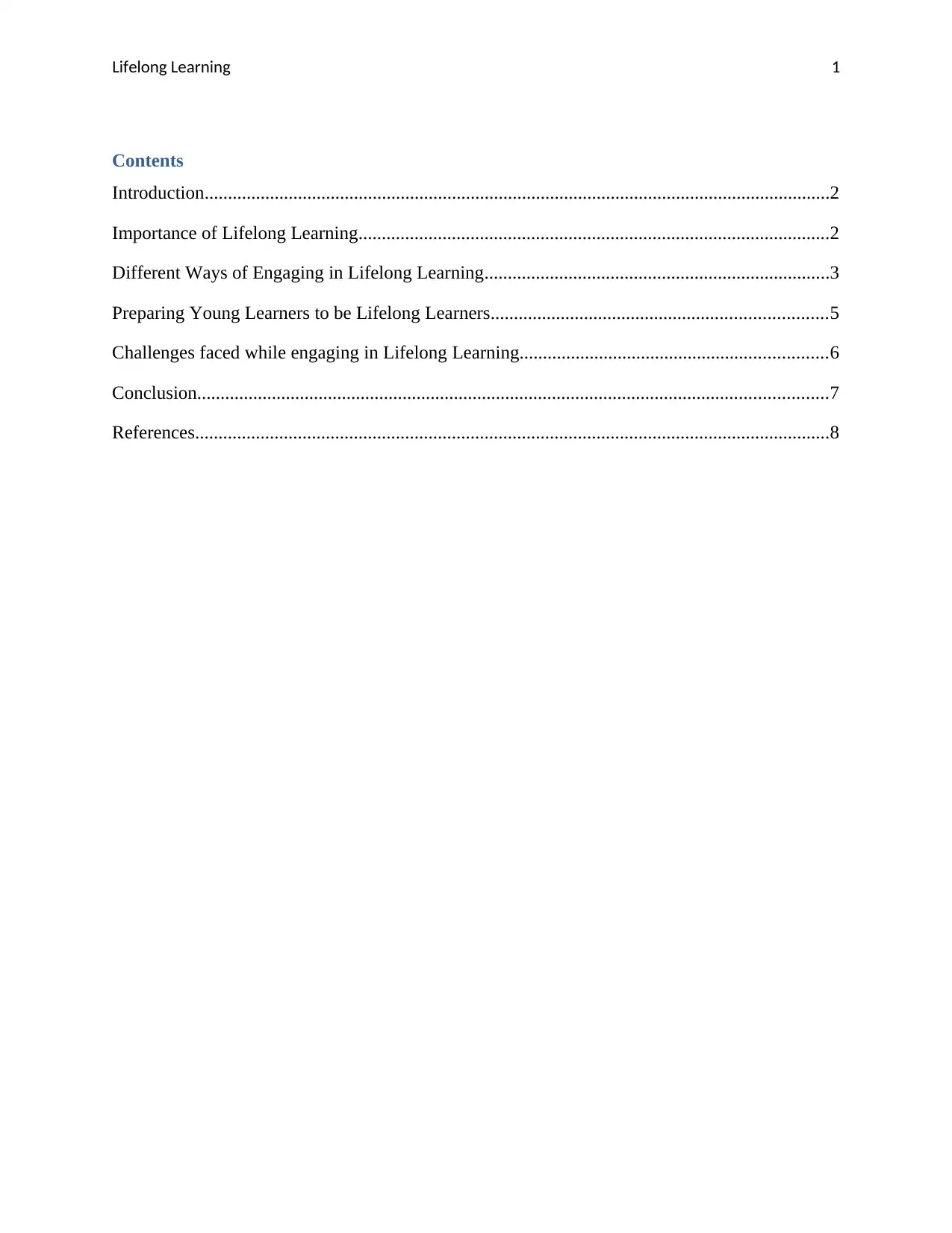
Lifelong Learning 1
Contents
Introduction......................................................................................................................................2
Importance of Lifelong Learning.....................................................................................................2
Different Ways of Engaging in Lifelong Learning..........................................................................3
Preparing Young Learners to be Lifelong Learners........................................................................5
Challenges faced while engaging in Lifelong Learning..................................................................6
Conclusion.......................................................................................................................................7
References........................................................................................................................................8
Contents
Introduction......................................................................................................................................2
Importance of Lifelong Learning.....................................................................................................2
Different Ways of Engaging in Lifelong Learning..........................................................................3
Preparing Young Learners to be Lifelong Learners........................................................................5
Challenges faced while engaging in Lifelong Learning..................................................................6
Conclusion.......................................................................................................................................7
References........................................................................................................................................8
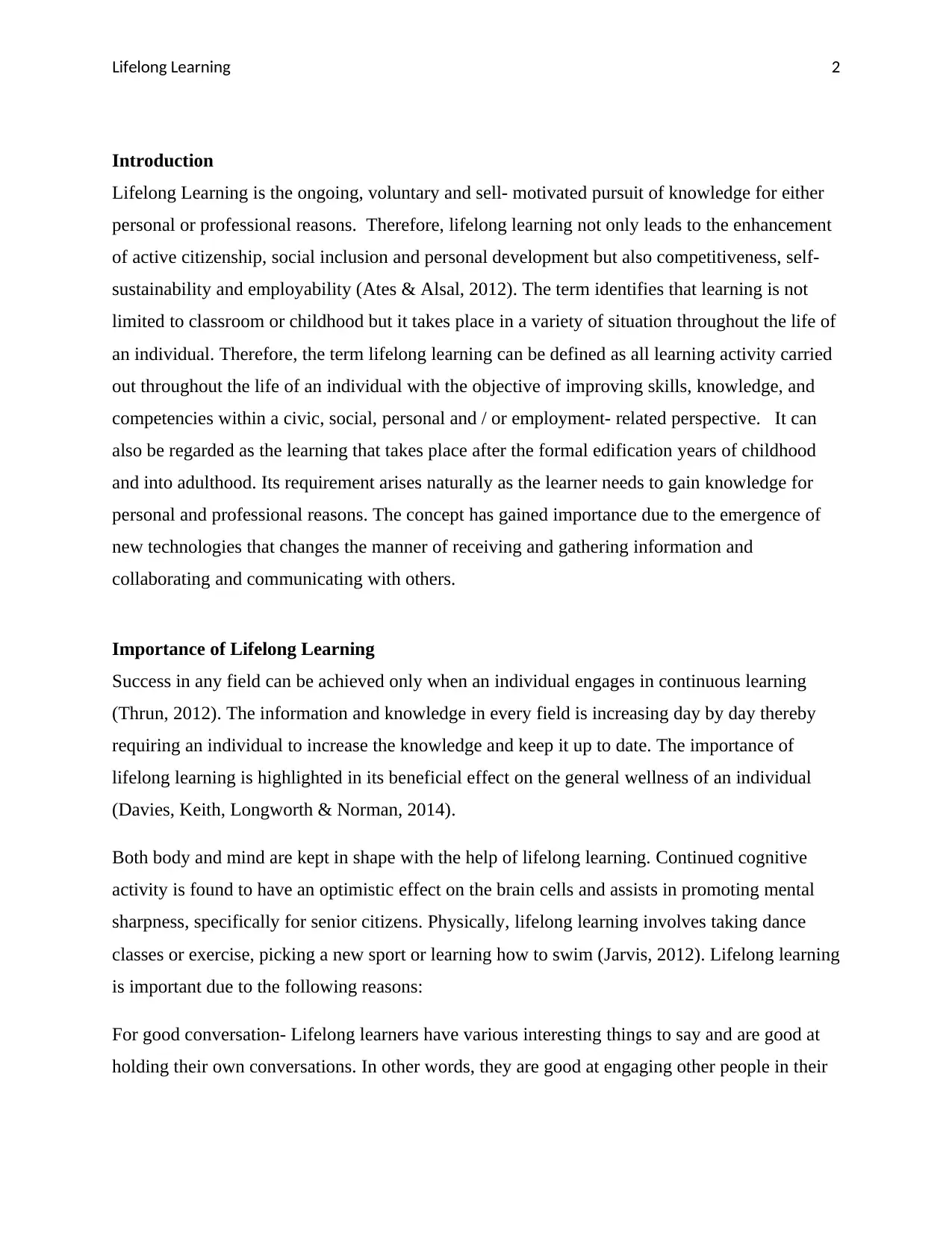
Lifelong Learning 2
Introduction
Lifelong Learning is the ongoing, voluntary and sell- motivated pursuit of knowledge for either
personal or professional reasons. Therefore, lifelong learning not only leads to the enhancement
of active citizenship, social inclusion and personal development but also competitiveness, self-
sustainability and employability (Ates & Alsal, 2012). The term identifies that learning is not
limited to classroom or childhood but it takes place in a variety of situation throughout the life of
an individual. Therefore, the term lifelong learning can be defined as all learning activity carried
out throughout the life of an individual with the objective of improving skills, knowledge, and
competencies within a civic, social, personal and / or employment- related perspective. It can
also be regarded as the learning that takes place after the formal edification years of childhood
and into adulthood. Its requirement arises naturally as the learner needs to gain knowledge for
personal and professional reasons. The concept has gained importance due to the emergence of
new technologies that changes the manner of receiving and gathering information and
collaborating and communicating with others.
Importance of Lifelong Learning
Success in any field can be achieved only when an individual engages in continuous learning
(Thrun, 2012). The information and knowledge in every field is increasing day by day thereby
requiring an individual to increase the knowledge and keep it up to date. The importance of
lifelong learning is highlighted in its beneficial effect on the general wellness of an individual
(Davies, Keith, Longworth & Norman, 2014).
Both body and mind are kept in shape with the help of lifelong learning. Continued cognitive
activity is found to have an optimistic effect on the brain cells and assists in promoting mental
sharpness, specifically for senior citizens. Physically, lifelong learning involves taking dance
classes or exercise, picking a new sport or learning how to swim (Jarvis, 2012). Lifelong learning
is important due to the following reasons:
For good conversation- Lifelong learners have various interesting things to say and are good at
holding their own conversations. In other words, they are good at engaging other people in their
Introduction
Lifelong Learning is the ongoing, voluntary and sell- motivated pursuit of knowledge for either
personal or professional reasons. Therefore, lifelong learning not only leads to the enhancement
of active citizenship, social inclusion and personal development but also competitiveness, self-
sustainability and employability (Ates & Alsal, 2012). The term identifies that learning is not
limited to classroom or childhood but it takes place in a variety of situation throughout the life of
an individual. Therefore, the term lifelong learning can be defined as all learning activity carried
out throughout the life of an individual with the objective of improving skills, knowledge, and
competencies within a civic, social, personal and / or employment- related perspective. It can
also be regarded as the learning that takes place after the formal edification years of childhood
and into adulthood. Its requirement arises naturally as the learner needs to gain knowledge for
personal and professional reasons. The concept has gained importance due to the emergence of
new technologies that changes the manner of receiving and gathering information and
collaborating and communicating with others.
Importance of Lifelong Learning
Success in any field can be achieved only when an individual engages in continuous learning
(Thrun, 2012). The information and knowledge in every field is increasing day by day thereby
requiring an individual to increase the knowledge and keep it up to date. The importance of
lifelong learning is highlighted in its beneficial effect on the general wellness of an individual
(Davies, Keith, Longworth & Norman, 2014).
Both body and mind are kept in shape with the help of lifelong learning. Continued cognitive
activity is found to have an optimistic effect on the brain cells and assists in promoting mental
sharpness, specifically for senior citizens. Physically, lifelong learning involves taking dance
classes or exercise, picking a new sport or learning how to swim (Jarvis, 2012). Lifelong learning
is important due to the following reasons:
For good conversation- Lifelong learners have various interesting things to say and are good at
holding their own conversations. In other words, they are good at engaging other people in their
⊘ This is a preview!⊘
Do you want full access?
Subscribe today to unlock all pages.

Trusted by 1+ million students worldwide
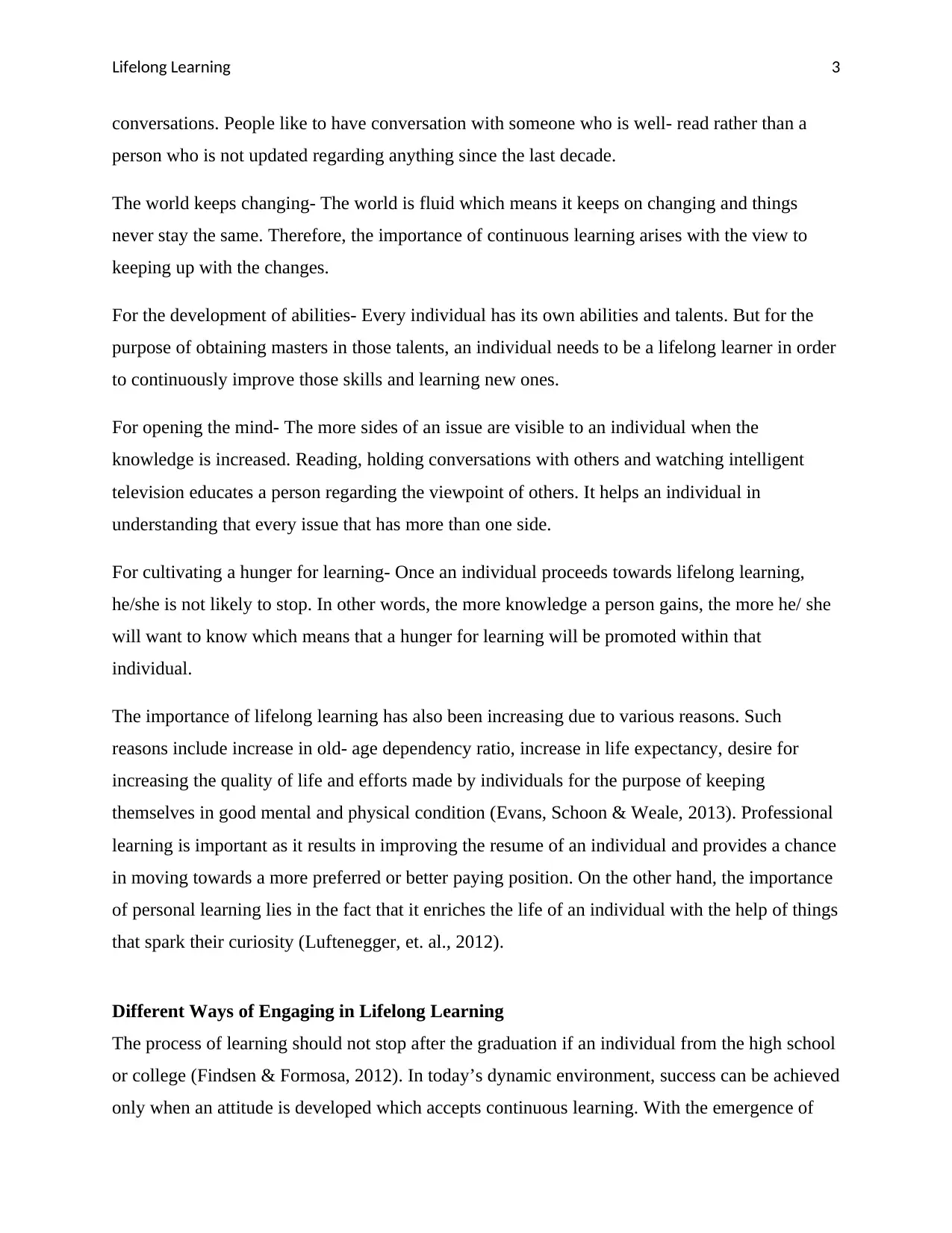
Lifelong Learning 3
conversations. People like to have conversation with someone who is well- read rather than a
person who is not updated regarding anything since the last decade.
The world keeps changing- The world is fluid which means it keeps on changing and things
never stay the same. Therefore, the importance of continuous learning arises with the view to
keeping up with the changes.
For the development of abilities- Every individual has its own abilities and talents. But for the
purpose of obtaining masters in those talents, an individual needs to be a lifelong learner in order
to continuously improve those skills and learning new ones.
For opening the mind- The more sides of an issue are visible to an individual when the
knowledge is increased. Reading, holding conversations with others and watching intelligent
television educates a person regarding the viewpoint of others. It helps an individual in
understanding that every issue that has more than one side.
For cultivating a hunger for learning- Once an individual proceeds towards lifelong learning,
he/she is not likely to stop. In other words, the more knowledge a person gains, the more he/ she
will want to know which means that a hunger for learning will be promoted within that
individual.
The importance of lifelong learning has also been increasing due to various reasons. Such
reasons include increase in old- age dependency ratio, increase in life expectancy, desire for
increasing the quality of life and efforts made by individuals for the purpose of keeping
themselves in good mental and physical condition (Evans, Schoon & Weale, 2013). Professional
learning is important as it results in improving the resume of an individual and provides a chance
in moving towards a more preferred or better paying position. On the other hand, the importance
of personal learning lies in the fact that it enriches the life of an individual with the help of things
that spark their curiosity (Luftenegger, et. al., 2012).
Different Ways of Engaging in Lifelong Learning
The process of learning should not stop after the graduation if an individual from the high school
or college (Findsen & Formosa, 2012). In today’s dynamic environment, success can be achieved
only when an attitude is developed which accepts continuous learning. With the emergence of
conversations. People like to have conversation with someone who is well- read rather than a
person who is not updated regarding anything since the last decade.
The world keeps changing- The world is fluid which means it keeps on changing and things
never stay the same. Therefore, the importance of continuous learning arises with the view to
keeping up with the changes.
For the development of abilities- Every individual has its own abilities and talents. But for the
purpose of obtaining masters in those talents, an individual needs to be a lifelong learner in order
to continuously improve those skills and learning new ones.
For opening the mind- The more sides of an issue are visible to an individual when the
knowledge is increased. Reading, holding conversations with others and watching intelligent
television educates a person regarding the viewpoint of others. It helps an individual in
understanding that every issue that has more than one side.
For cultivating a hunger for learning- Once an individual proceeds towards lifelong learning,
he/she is not likely to stop. In other words, the more knowledge a person gains, the more he/ she
will want to know which means that a hunger for learning will be promoted within that
individual.
The importance of lifelong learning has also been increasing due to various reasons. Such
reasons include increase in old- age dependency ratio, increase in life expectancy, desire for
increasing the quality of life and efforts made by individuals for the purpose of keeping
themselves in good mental and physical condition (Evans, Schoon & Weale, 2013). Professional
learning is important as it results in improving the resume of an individual and provides a chance
in moving towards a more preferred or better paying position. On the other hand, the importance
of personal learning lies in the fact that it enriches the life of an individual with the help of things
that spark their curiosity (Luftenegger, et. al., 2012).
Different Ways of Engaging in Lifelong Learning
The process of learning should not stop after the graduation if an individual from the high school
or college (Findsen & Formosa, 2012). In today’s dynamic environment, success can be achieved
only when an attitude is developed which accepts continuous learning. With the emergence of
Paraphrase This Document
Need a fresh take? Get an instant paraphrase of this document with our AI Paraphraser
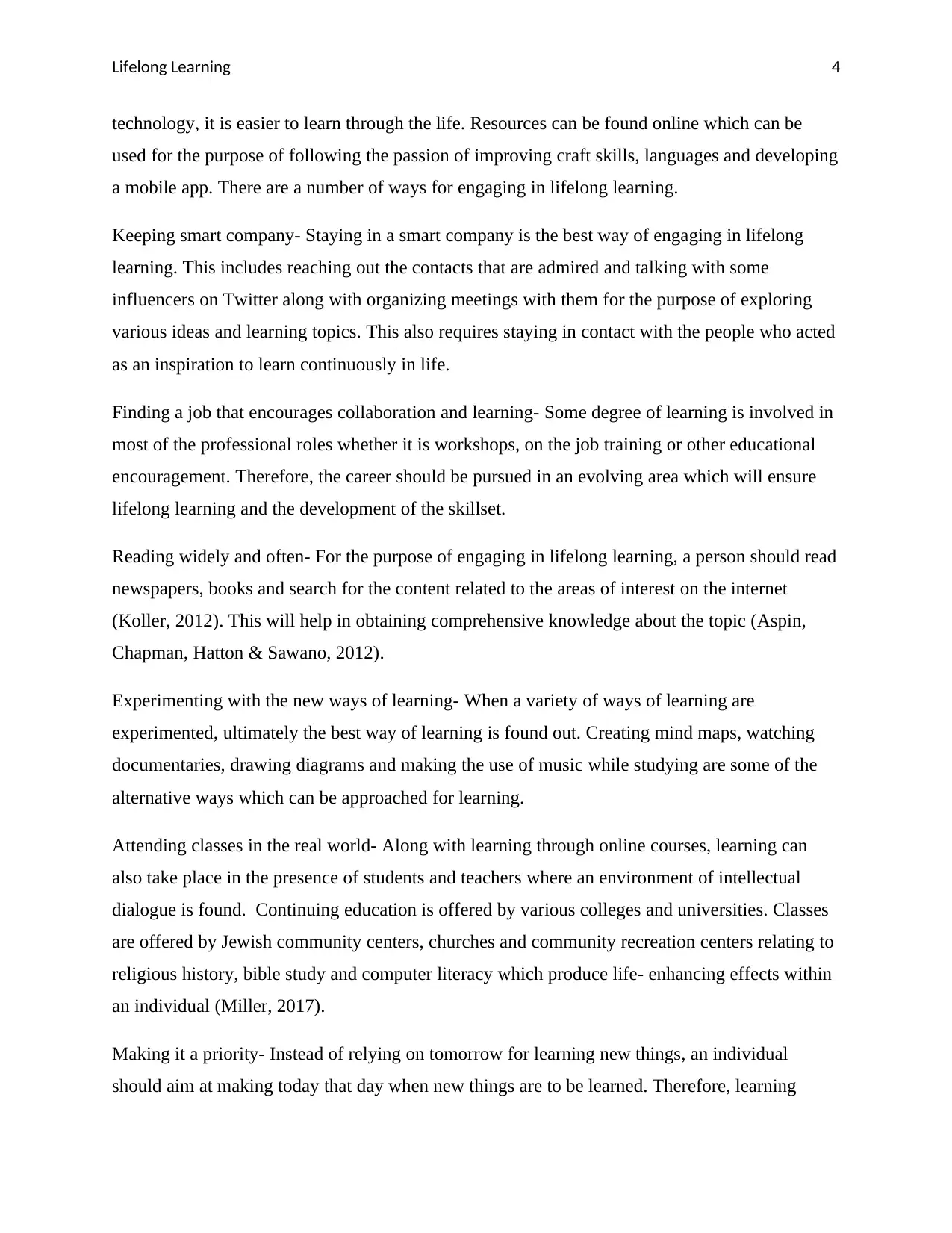
Lifelong Learning 4
technology, it is easier to learn through the life. Resources can be found online which can be
used for the purpose of following the passion of improving craft skills, languages and developing
a mobile app. There are a number of ways for engaging in lifelong learning.
Keeping smart company- Staying in a smart company is the best way of engaging in lifelong
learning. This includes reaching out the contacts that are admired and talking with some
influencers on Twitter along with organizing meetings with them for the purpose of exploring
various ideas and learning topics. This also requires staying in contact with the people who acted
as an inspiration to learn continuously in life.
Finding a job that encourages collaboration and learning- Some degree of learning is involved in
most of the professional roles whether it is workshops, on the job training or other educational
encouragement. Therefore, the career should be pursued in an evolving area which will ensure
lifelong learning and the development of the skillset.
Reading widely and often- For the purpose of engaging in lifelong learning, a person should read
newspapers, books and search for the content related to the areas of interest on the internet
(Koller, 2012). This will help in obtaining comprehensive knowledge about the topic (Aspin,
Chapman, Hatton & Sawano, 2012).
Experimenting with the new ways of learning- When a variety of ways of learning are
experimented, ultimately the best way of learning is found out. Creating mind maps, watching
documentaries, drawing diagrams and making the use of music while studying are some of the
alternative ways which can be approached for learning.
Attending classes in the real world- Along with learning through online courses, learning can
also take place in the presence of students and teachers where an environment of intellectual
dialogue is found. Continuing education is offered by various colleges and universities. Classes
are offered by Jewish community centers, churches and community recreation centers relating to
religious history, bible study and computer literacy which produce life- enhancing effects within
an individual (Miller, 2017).
Making it a priority- Instead of relying on tomorrow for learning new things, an individual
should aim at making today that day when new things are to be learned. Therefore, learning
technology, it is easier to learn through the life. Resources can be found online which can be
used for the purpose of following the passion of improving craft skills, languages and developing
a mobile app. There are a number of ways for engaging in lifelong learning.
Keeping smart company- Staying in a smart company is the best way of engaging in lifelong
learning. This includes reaching out the contacts that are admired and talking with some
influencers on Twitter along with organizing meetings with them for the purpose of exploring
various ideas and learning topics. This also requires staying in contact with the people who acted
as an inspiration to learn continuously in life.
Finding a job that encourages collaboration and learning- Some degree of learning is involved in
most of the professional roles whether it is workshops, on the job training or other educational
encouragement. Therefore, the career should be pursued in an evolving area which will ensure
lifelong learning and the development of the skillset.
Reading widely and often- For the purpose of engaging in lifelong learning, a person should read
newspapers, books and search for the content related to the areas of interest on the internet
(Koller, 2012). This will help in obtaining comprehensive knowledge about the topic (Aspin,
Chapman, Hatton & Sawano, 2012).
Experimenting with the new ways of learning- When a variety of ways of learning are
experimented, ultimately the best way of learning is found out. Creating mind maps, watching
documentaries, drawing diagrams and making the use of music while studying are some of the
alternative ways which can be approached for learning.
Attending classes in the real world- Along with learning through online courses, learning can
also take place in the presence of students and teachers where an environment of intellectual
dialogue is found. Continuing education is offered by various colleges and universities. Classes
are offered by Jewish community centers, churches and community recreation centers relating to
religious history, bible study and computer literacy which produce life- enhancing effects within
an individual (Miller, 2017).
Making it a priority- Instead of relying on tomorrow for learning new things, an individual
should aim at making today that day when new things are to be learned. Therefore, learning
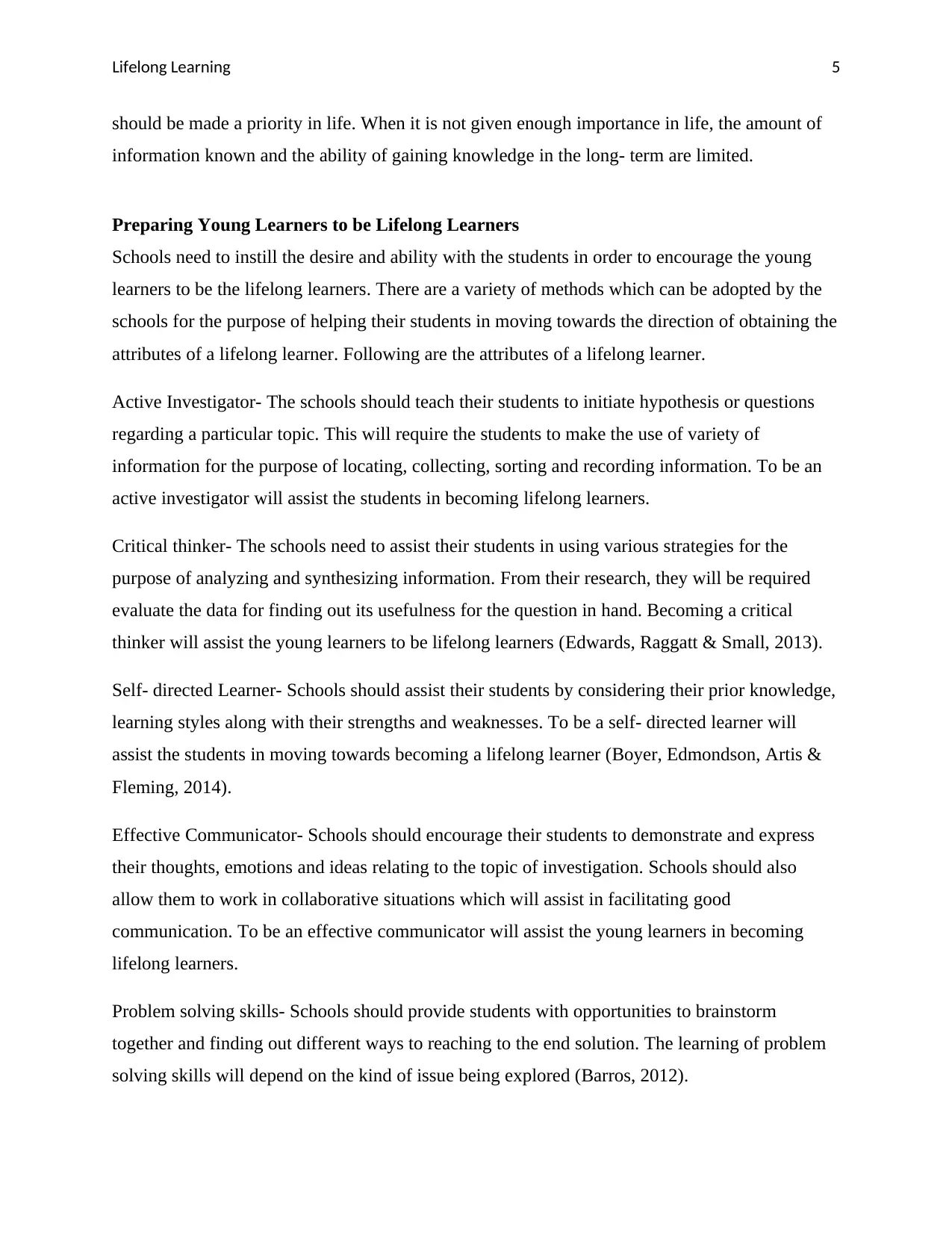
Lifelong Learning 5
should be made a priority in life. When it is not given enough importance in life, the amount of
information known and the ability of gaining knowledge in the long- term are limited.
Preparing Young Learners to be Lifelong Learners
Schools need to instill the desire and ability with the students in order to encourage the young
learners to be the lifelong learners. There are a variety of methods which can be adopted by the
schools for the purpose of helping their students in moving towards the direction of obtaining the
attributes of a lifelong learner. Following are the attributes of a lifelong learner.
Active Investigator- The schools should teach their students to initiate hypothesis or questions
regarding a particular topic. This will require the students to make the use of variety of
information for the purpose of locating, collecting, sorting and recording information. To be an
active investigator will assist the students in becoming lifelong learners.
Critical thinker- The schools need to assist their students in using various strategies for the
purpose of analyzing and synthesizing information. From their research, they will be required
evaluate the data for finding out its usefulness for the question in hand. Becoming a critical
thinker will assist the young learners to be lifelong learners (Edwards, Raggatt & Small, 2013).
Self- directed Learner- Schools should assist their students by considering their prior knowledge,
learning styles along with their strengths and weaknesses. To be a self- directed learner will
assist the students in moving towards becoming a lifelong learner (Boyer, Edmondson, Artis &
Fleming, 2014).
Effective Communicator- Schools should encourage their students to demonstrate and express
their thoughts, emotions and ideas relating to the topic of investigation. Schools should also
allow them to work in collaborative situations which will assist in facilitating good
communication. To be an effective communicator will assist the young learners in becoming
lifelong learners.
Problem solving skills- Schools should provide students with opportunities to brainstorm
together and finding out different ways to reaching to the end solution. The learning of problem
solving skills will depend on the kind of issue being explored (Barros, 2012).
should be made a priority in life. When it is not given enough importance in life, the amount of
information known and the ability of gaining knowledge in the long- term are limited.
Preparing Young Learners to be Lifelong Learners
Schools need to instill the desire and ability with the students in order to encourage the young
learners to be the lifelong learners. There are a variety of methods which can be adopted by the
schools for the purpose of helping their students in moving towards the direction of obtaining the
attributes of a lifelong learner. Following are the attributes of a lifelong learner.
Active Investigator- The schools should teach their students to initiate hypothesis or questions
regarding a particular topic. This will require the students to make the use of variety of
information for the purpose of locating, collecting, sorting and recording information. To be an
active investigator will assist the students in becoming lifelong learners.
Critical thinker- The schools need to assist their students in using various strategies for the
purpose of analyzing and synthesizing information. From their research, they will be required
evaluate the data for finding out its usefulness for the question in hand. Becoming a critical
thinker will assist the young learners to be lifelong learners (Edwards, Raggatt & Small, 2013).
Self- directed Learner- Schools should assist their students by considering their prior knowledge,
learning styles along with their strengths and weaknesses. To be a self- directed learner will
assist the students in moving towards becoming a lifelong learner (Boyer, Edmondson, Artis &
Fleming, 2014).
Effective Communicator- Schools should encourage their students to demonstrate and express
their thoughts, emotions and ideas relating to the topic of investigation. Schools should also
allow them to work in collaborative situations which will assist in facilitating good
communication. To be an effective communicator will assist the young learners in becoming
lifelong learners.
Problem solving skills- Schools should provide students with opportunities to brainstorm
together and finding out different ways to reaching to the end solution. The learning of problem
solving skills will depend on the kind of issue being explored (Barros, 2012).
⊘ This is a preview!⊘
Do you want full access?
Subscribe today to unlock all pages.

Trusted by 1+ million students worldwide
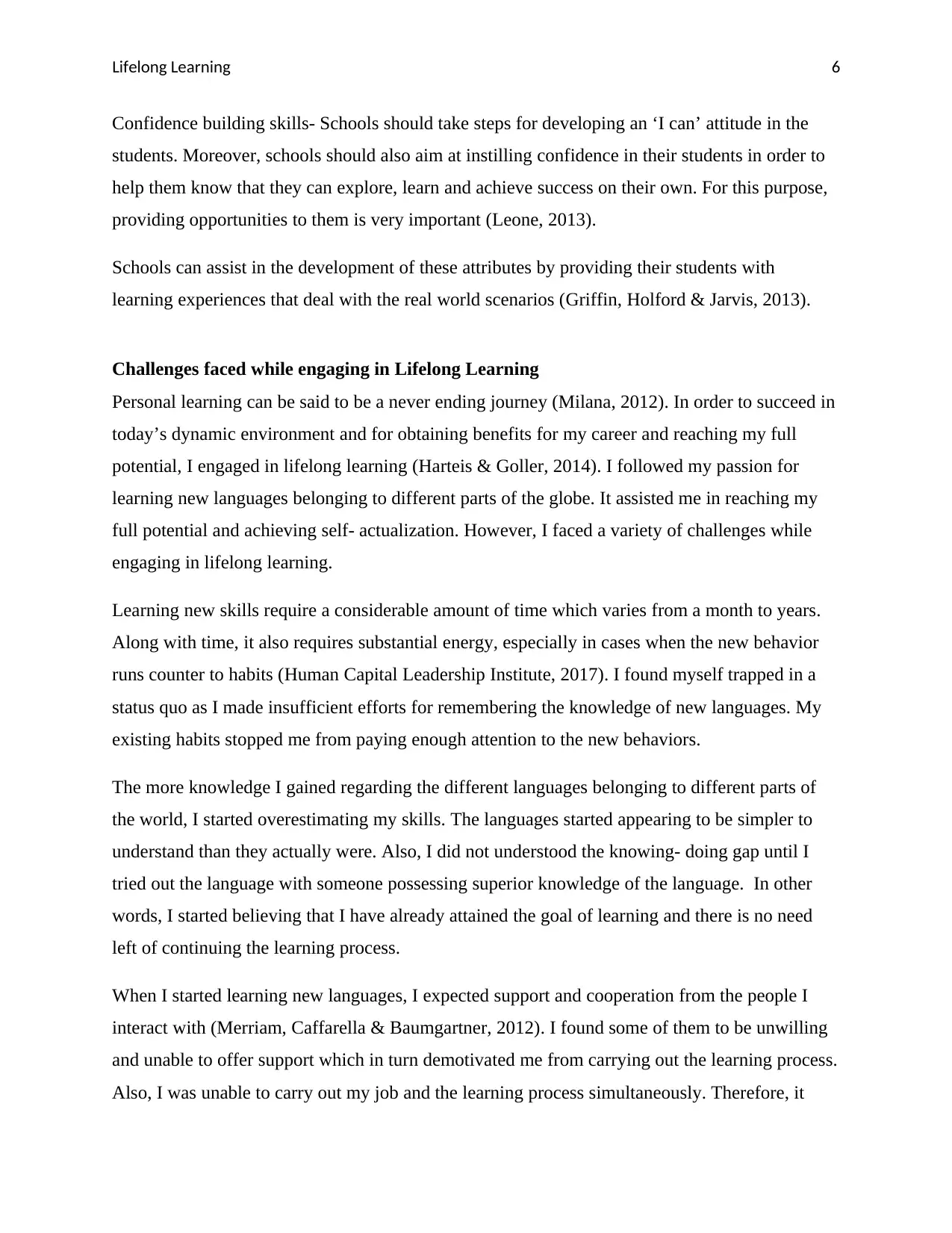
Lifelong Learning 6
Confidence building skills- Schools should take steps for developing an ‘I can’ attitude in the
students. Moreover, schools should also aim at instilling confidence in their students in order to
help them know that they can explore, learn and achieve success on their own. For this purpose,
providing opportunities to them is very important (Leone, 2013).
Schools can assist in the development of these attributes by providing their students with
learning experiences that deal with the real world scenarios (Griffin, Holford & Jarvis, 2013).
Challenges faced while engaging in Lifelong Learning
Personal learning can be said to be a never ending journey (Milana, 2012). In order to succeed in
today’s dynamic environment and for obtaining benefits for my career and reaching my full
potential, I engaged in lifelong learning (Harteis & Goller, 2014). I followed my passion for
learning new languages belonging to different parts of the globe. It assisted me in reaching my
full potential and achieving self- actualization. However, I faced a variety of challenges while
engaging in lifelong learning.
Learning new skills require a considerable amount of time which varies from a month to years.
Along with time, it also requires substantial energy, especially in cases when the new behavior
runs counter to habits (Human Capital Leadership Institute, 2017). I found myself trapped in a
status quo as I made insufficient efforts for remembering the knowledge of new languages. My
existing habits stopped me from paying enough attention to the new behaviors.
The more knowledge I gained regarding the different languages belonging to different parts of
the world, I started overestimating my skills. The languages started appearing to be simpler to
understand than they actually were. Also, I did not understood the knowing- doing gap until I
tried out the language with someone possessing superior knowledge of the language. In other
words, I started believing that I have already attained the goal of learning and there is no need
left of continuing the learning process.
When I started learning new languages, I expected support and cooperation from the people I
interact with (Merriam, Caffarella & Baumgartner, 2012). I found some of them to be unwilling
and unable to offer support which in turn demotivated me from carrying out the learning process.
Also, I was unable to carry out my job and the learning process simultaneously. Therefore, it
Confidence building skills- Schools should take steps for developing an ‘I can’ attitude in the
students. Moreover, schools should also aim at instilling confidence in their students in order to
help them know that they can explore, learn and achieve success on their own. For this purpose,
providing opportunities to them is very important (Leone, 2013).
Schools can assist in the development of these attributes by providing their students with
learning experiences that deal with the real world scenarios (Griffin, Holford & Jarvis, 2013).
Challenges faced while engaging in Lifelong Learning
Personal learning can be said to be a never ending journey (Milana, 2012). In order to succeed in
today’s dynamic environment and for obtaining benefits for my career and reaching my full
potential, I engaged in lifelong learning (Harteis & Goller, 2014). I followed my passion for
learning new languages belonging to different parts of the globe. It assisted me in reaching my
full potential and achieving self- actualization. However, I faced a variety of challenges while
engaging in lifelong learning.
Learning new skills require a considerable amount of time which varies from a month to years.
Along with time, it also requires substantial energy, especially in cases when the new behavior
runs counter to habits (Human Capital Leadership Institute, 2017). I found myself trapped in a
status quo as I made insufficient efforts for remembering the knowledge of new languages. My
existing habits stopped me from paying enough attention to the new behaviors.
The more knowledge I gained regarding the different languages belonging to different parts of
the world, I started overestimating my skills. The languages started appearing to be simpler to
understand than they actually were. Also, I did not understood the knowing- doing gap until I
tried out the language with someone possessing superior knowledge of the language. In other
words, I started believing that I have already attained the goal of learning and there is no need
left of continuing the learning process.
When I started learning new languages, I expected support and cooperation from the people I
interact with (Merriam, Caffarella & Baumgartner, 2012). I found some of them to be unwilling
and unable to offer support which in turn demotivated me from carrying out the learning process.
Also, I was unable to carry out my job and the learning process simultaneously. Therefore, it
Paraphrase This Document
Need a fresh take? Get an instant paraphrase of this document with our AI Paraphraser
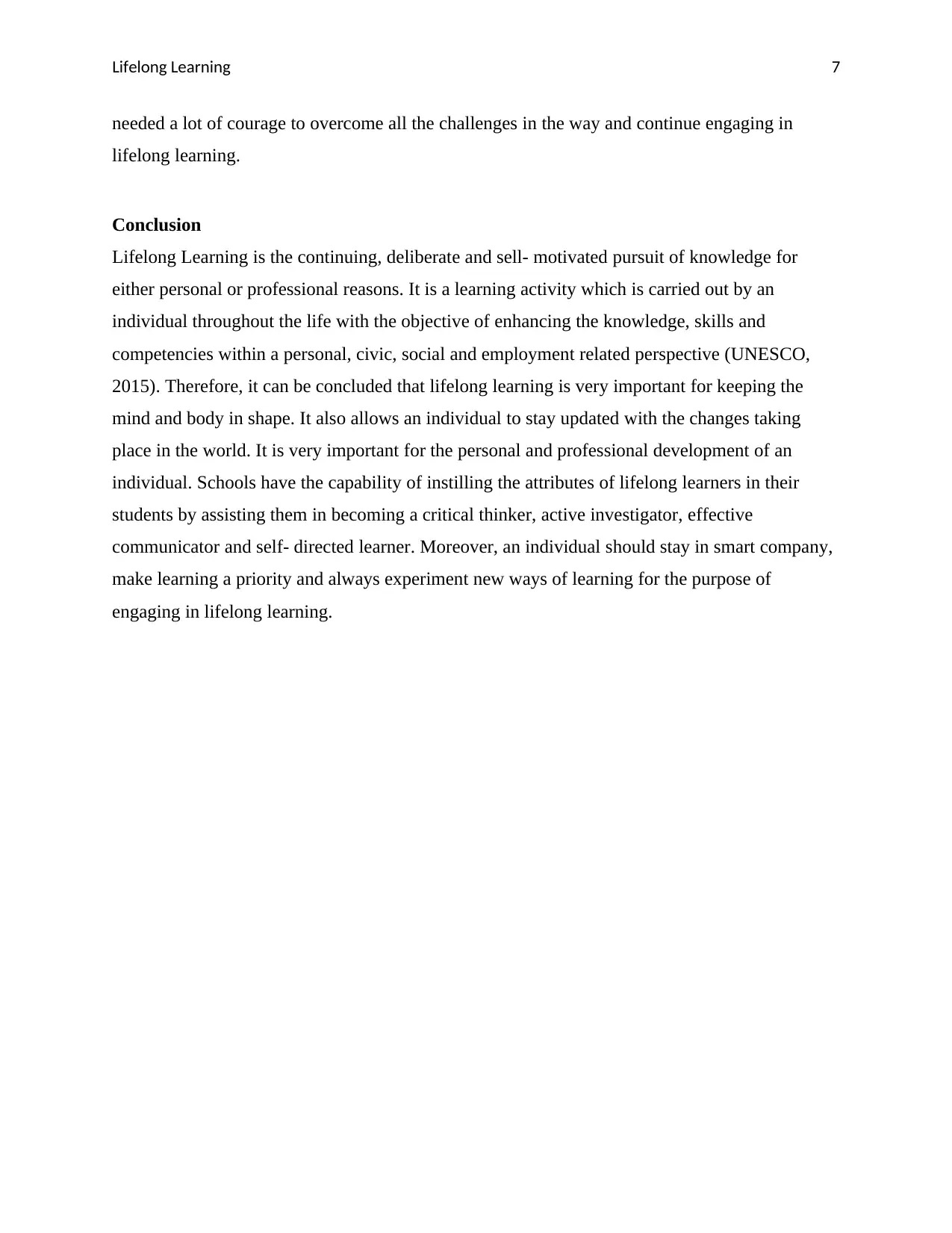
Lifelong Learning 7
needed a lot of courage to overcome all the challenges in the way and continue engaging in
lifelong learning.
Conclusion
Lifelong Learning is the continuing, deliberate and sell- motivated pursuit of knowledge for
either personal or professional reasons. It is a learning activity which is carried out by an
individual throughout the life with the objective of enhancing the knowledge, skills and
competencies within a personal, civic, social and employment related perspective (UNESCO,
2015). Therefore, it can be concluded that lifelong learning is very important for keeping the
mind and body in shape. It also allows an individual to stay updated with the changes taking
place in the world. It is very important for the personal and professional development of an
individual. Schools have the capability of instilling the attributes of lifelong learners in their
students by assisting them in becoming a critical thinker, active investigator, effective
communicator and self- directed learner. Moreover, an individual should stay in smart company,
make learning a priority and always experiment new ways of learning for the purpose of
engaging in lifelong learning.
needed a lot of courage to overcome all the challenges in the way and continue engaging in
lifelong learning.
Conclusion
Lifelong Learning is the continuing, deliberate and sell- motivated pursuit of knowledge for
either personal or professional reasons. It is a learning activity which is carried out by an
individual throughout the life with the objective of enhancing the knowledge, skills and
competencies within a personal, civic, social and employment related perspective (UNESCO,
2015). Therefore, it can be concluded that lifelong learning is very important for keeping the
mind and body in shape. It also allows an individual to stay updated with the changes taking
place in the world. It is very important for the personal and professional development of an
individual. Schools have the capability of instilling the attributes of lifelong learners in their
students by assisting them in becoming a critical thinker, active investigator, effective
communicator and self- directed learner. Moreover, an individual should stay in smart company,
make learning a priority and always experiment new ways of learning for the purpose of
engaging in lifelong learning.
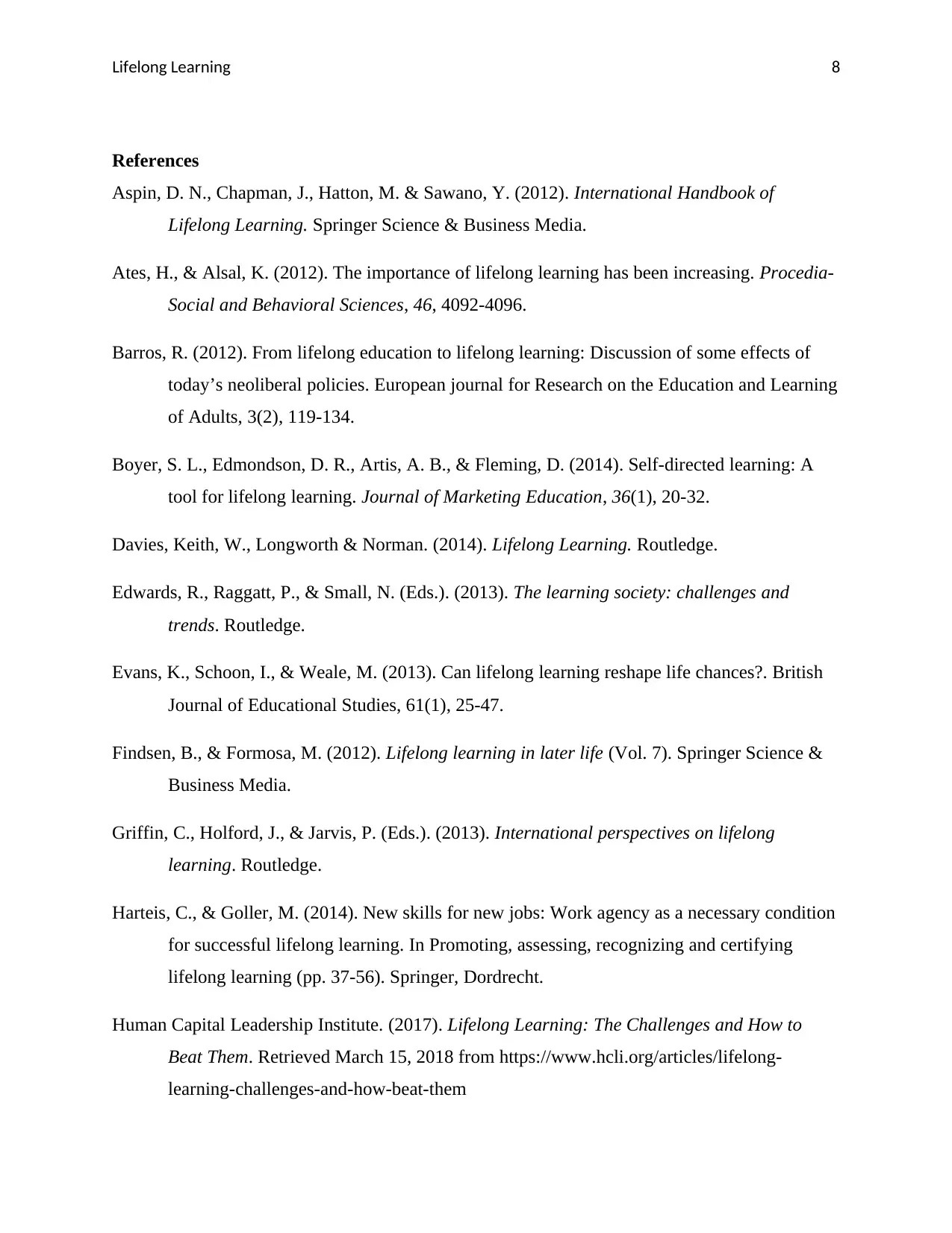
Lifelong Learning 8
References
Aspin, D. N., Chapman, J., Hatton, M. & Sawano, Y. (2012). International Handbook of
Lifelong Learning. Springer Science & Business Media.
Ates, H., & Alsal, K. (2012). The importance of lifelong learning has been increasing. Procedia-
Social and Behavioral Sciences, 46, 4092-4096.
Barros, R. (2012). From lifelong education to lifelong learning: Discussion of some effects of
today’s neoliberal policies. European journal for Research on the Education and Learning
of Adults, 3(2), 119-134.
Boyer, S. L., Edmondson, D. R., Artis, A. B., & Fleming, D. (2014). Self-directed learning: A
tool for lifelong learning. Journal of Marketing Education, 36(1), 20-32.
Davies, Keith, W., Longworth & Norman. (2014). Lifelong Learning. Routledge.
Edwards, R., Raggatt, P., & Small, N. (Eds.). (2013). The learning society: challenges and
trends. Routledge.
Evans, K., Schoon, I., & Weale, M. (2013). Can lifelong learning reshape life chances?. British
Journal of Educational Studies, 61(1), 25-47.
Findsen, B., & Formosa, M. (2012). Lifelong learning in later life (Vol. 7). Springer Science &
Business Media.
Griffin, C., Holford, J., & Jarvis, P. (Eds.). (2013). International perspectives on lifelong
learning. Routledge.
Harteis, C., & Goller, M. (2014). New skills for new jobs: Work agency as a necessary condition
for successful lifelong learning. In Promoting, assessing, recognizing and certifying
lifelong learning (pp. 37-56). Springer, Dordrecht.
Human Capital Leadership Institute. (2017). Lifelong Learning: The Challenges and How to
Beat Them. Retrieved March 15, 2018 from https://www.hcli.org/articles/lifelong-
learning-challenges-and-how-beat-them
References
Aspin, D. N., Chapman, J., Hatton, M. & Sawano, Y. (2012). International Handbook of
Lifelong Learning. Springer Science & Business Media.
Ates, H., & Alsal, K. (2012). The importance of lifelong learning has been increasing. Procedia-
Social and Behavioral Sciences, 46, 4092-4096.
Barros, R. (2012). From lifelong education to lifelong learning: Discussion of some effects of
today’s neoliberal policies. European journal for Research on the Education and Learning
of Adults, 3(2), 119-134.
Boyer, S. L., Edmondson, D. R., Artis, A. B., & Fleming, D. (2014). Self-directed learning: A
tool for lifelong learning. Journal of Marketing Education, 36(1), 20-32.
Davies, Keith, W., Longworth & Norman. (2014). Lifelong Learning. Routledge.
Edwards, R., Raggatt, P., & Small, N. (Eds.). (2013). The learning society: challenges and
trends. Routledge.
Evans, K., Schoon, I., & Weale, M. (2013). Can lifelong learning reshape life chances?. British
Journal of Educational Studies, 61(1), 25-47.
Findsen, B., & Formosa, M. (2012). Lifelong learning in later life (Vol. 7). Springer Science &
Business Media.
Griffin, C., Holford, J., & Jarvis, P. (Eds.). (2013). International perspectives on lifelong
learning. Routledge.
Harteis, C., & Goller, M. (2014). New skills for new jobs: Work agency as a necessary condition
for successful lifelong learning. In Promoting, assessing, recognizing and certifying
lifelong learning (pp. 37-56). Springer, Dordrecht.
Human Capital Leadership Institute. (2017). Lifelong Learning: The Challenges and How to
Beat Them. Retrieved March 15, 2018 from https://www.hcli.org/articles/lifelong-
learning-challenges-and-how-beat-them
⊘ This is a preview!⊘
Do you want full access?
Subscribe today to unlock all pages.

Trusted by 1+ million students worldwide
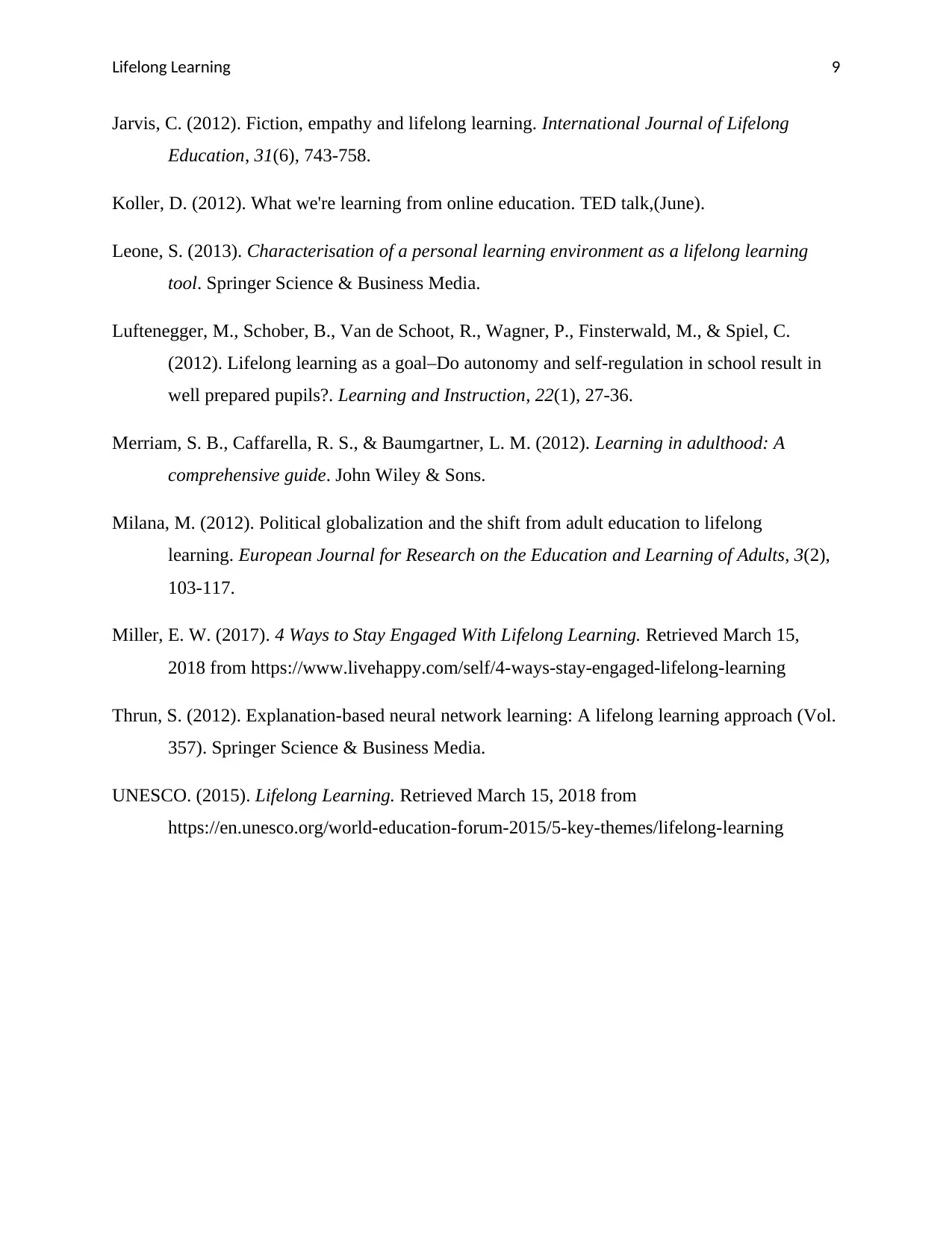
Lifelong Learning 9
Jarvis, C. (2012). Fiction, empathy and lifelong learning. International Journal of Lifelong
Education, 31(6), 743-758.
Koller, D. (2012). What we're learning from online education. TED talk,(June).
Leone, S. (2013). Characterisation of a personal learning environment as a lifelong learning
tool. Springer Science & Business Media.
Luftenegger, M., Schober, B., Van de Schoot, R., Wagner, P., Finsterwald, M., & Spiel, C.
(2012). Lifelong learning as a goal–Do autonomy and self-regulation in school result in
well prepared pupils?. Learning and Instruction, 22(1), 27-36.
Merriam, S. B., Caffarella, R. S., & Baumgartner, L. M. (2012). Learning in adulthood: A
comprehensive guide. John Wiley & Sons.
Milana, M. (2012). Political globalization and the shift from adult education to lifelong
learning. European Journal for Research on the Education and Learning of Adults, 3(2),
103-117.
Miller, E. W. (2017). 4 Ways to Stay Engaged With Lifelong Learning. Retrieved March 15,
2018 from https://www.livehappy.com/self/4-ways-stay-engaged-lifelong-learning
Thrun, S. (2012). Explanation-based neural network learning: A lifelong learning approach (Vol.
357). Springer Science & Business Media.
UNESCO. (2015). Lifelong Learning. Retrieved March 15, 2018 from
https://en.unesco.org/world-education-forum-2015/5-key-themes/lifelong-learning
Jarvis, C. (2012). Fiction, empathy and lifelong learning. International Journal of Lifelong
Education, 31(6), 743-758.
Koller, D. (2012). What we're learning from online education. TED talk,(June).
Leone, S. (2013). Characterisation of a personal learning environment as a lifelong learning
tool. Springer Science & Business Media.
Luftenegger, M., Schober, B., Van de Schoot, R., Wagner, P., Finsterwald, M., & Spiel, C.
(2012). Lifelong learning as a goal–Do autonomy and self-regulation in school result in
well prepared pupils?. Learning and Instruction, 22(1), 27-36.
Merriam, S. B., Caffarella, R. S., & Baumgartner, L. M. (2012). Learning in adulthood: A
comprehensive guide. John Wiley & Sons.
Milana, M. (2012). Political globalization and the shift from adult education to lifelong
learning. European Journal for Research on the Education and Learning of Adults, 3(2),
103-117.
Miller, E. W. (2017). 4 Ways to Stay Engaged With Lifelong Learning. Retrieved March 15,
2018 from https://www.livehappy.com/self/4-ways-stay-engaged-lifelong-learning
Thrun, S. (2012). Explanation-based neural network learning: A lifelong learning approach (Vol.
357). Springer Science & Business Media.
UNESCO. (2015). Lifelong Learning. Retrieved March 15, 2018 from
https://en.unesco.org/world-education-forum-2015/5-key-themes/lifelong-learning
1 out of 10
Related Documents
Your All-in-One AI-Powered Toolkit for Academic Success.
+13062052269
info@desklib.com
Available 24*7 on WhatsApp / Email
![[object Object]](/_next/static/media/star-bottom.7253800d.svg)
Unlock your academic potential
Copyright © 2020–2025 A2Z Services. All Rights Reserved. Developed and managed by ZUCOL.




